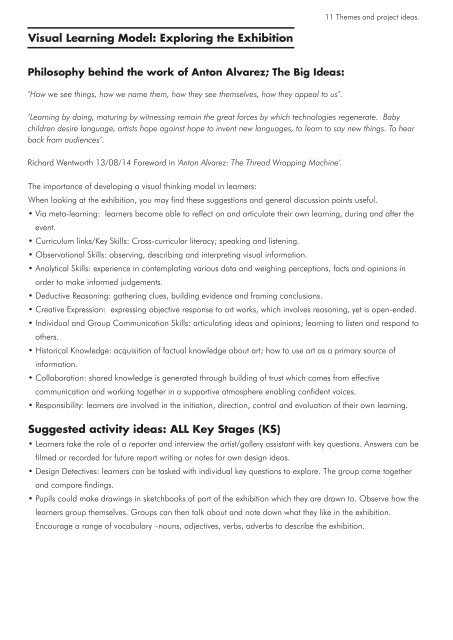Anton Alvarez Alphabet Aerobics
1ZPYI8x
1ZPYI8x
You also want an ePaper? Increase the reach of your titles
YUMPU automatically turns print PDFs into web optimized ePapers that Google loves.
11 Themes and project ideas.<br />
Visual Learning Model: Exploring the Exhibition<br />
Philosophy behind the work of <strong>Anton</strong> <strong>Alvarez</strong>; The Big Ideas:<br />
‘How we see things, how we name them, how they see themselves, how they appeal to us’.<br />
‘Learning by doing, maturing by witnessing remain the great forces by which technologies regenerate. Baby<br />
children desire language, artists hope against hope to invent new languages, to learn to say new things. To hear<br />
back from audiences’.<br />
Richard Wentworth 13/08/14 Foreword in '<strong>Anton</strong> <strong>Alvarez</strong>: The Thread Wrapping Machine'.<br />
The importance of developing a visual thinking model in learners:<br />
When looking at the exhibition, you may find these suggestions and general discussion points useful.<br />
• Via meta-learning: learners become able to reflect on and articulate their own learning, during and after the<br />
event.<br />
• Curriculum links/Key Skills: Cross-curricular literacy; speaking and listening.<br />
• Observational Skills: observing, describing and interpreting visual information.<br />
• Analytical Skills: experience in contemplating various data and weighing perceptions, facts and opinions in<br />
order to make informed judgements.<br />
• Deductive Reasoning: gathering clues, building evidence and framing conclusions.<br />
• Creative Expression: expressing objective response to art works, which involves reasoning, yet is open-ended.<br />
• Individual and Group Communication Skills: articulating ideas and opinions; learning to listen and respond to<br />
others.<br />
• Historical Knowledge: acquisition of factual knowledge about art; how to use art as a primary source of<br />
information.<br />
• Collaboration: shared knowledge is generated through building of trust which comes from effective<br />
communication and working together in a supportive atmosphere enabling confident voices.<br />
• Responsibility: learners are involved in the initiation, direction, control and evaluation of their own learning.<br />
Suggested activity ideas: ALL Key Stages (KS)<br />
• Learners take the role of a reporter and interview the artist/gallery assistant with key questions. Answers can be<br />
filmed or recorded for future report writing or notes for own design ideas.<br />
• Design Detectives: learners can be tasked with individual key questions to explore. The group come together<br />
and compare findings.<br />
• Pupils could make drawings in sketchbooks of part of the exhibition which they are drawn to. Observe how the<br />
learners group themselves. Groups can then talk about and note down what they like in the exhibition.<br />
Encourage a range of vocabulary –nouns, adjectives, verbs, adverbs to describe the exhibition.


